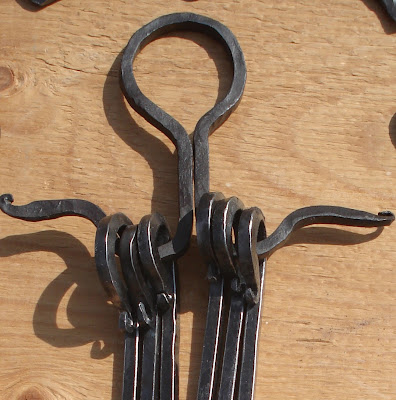Solid skewers
My skewers seem to be big and bold.
They are not the size asian industry has imposed on us. They are not mere heavy wire. They are one quarter inch steel. It is a superior size. It does yield a superior skewer.
That size makes it a real tool in the hand. It does not roll when piercing meat. It does not slip either. You can push through easily.
They also work æsthetically. They are nice to look at. They are different from what is sold in commerce. They look like ... well what skewers ought to look like...
That size makes it a real tool in the hand. It does not roll when piercing meat. It does not slip either. You can push through easily.
 |
| The skewer holder has its arms full... |
They also work æsthetically. They are nice to look at. They are different from what is sold in commerce. They look like ... well what skewers ought to look like...
Historical skewers
That is if we believe Alex Bealer in his "The Art of Blacksmithing" (page 273):
Among the more attractive and interesting items made for the kitchen by medieval and later smiths were meat skewers and skewer holders. The skewers, in simplest form, are only 1/4-inch or 3/16-inch rods or square bars 7- or 8- inches long...
And a shorter version?
 |
| Trussing needle and a skewer similar with its double twist to the one Bealer admired a page later. |
I also forge a shorter version.
They are very efficient as trussing needles. These permit to easily close with string the opening of a stuffed bird or to tie the side of a pork roast you have split and opened like a book and stuffed with a lot of garlic, some salt, a lot of pepper (freshly ground is better) and the same amount of rosemary and a little olive oil all around and garlic slices you insert outside and its ready when odors get out of the oven and talk to you...
They are very efficient as trussing needles. These permit to easily close with string the opening of a stuffed bird or to tie the side of a pork roast you have split and opened like a book and stuffed with a lot of garlic, some salt, a lot of pepper (freshly ground is better) and the same amount of rosemary and a little olive oil all around and garlic slices you insert outside and its ready when odors get out of the oven and talk to you...


Aucun commentaire:
Enregistrer un commentaire